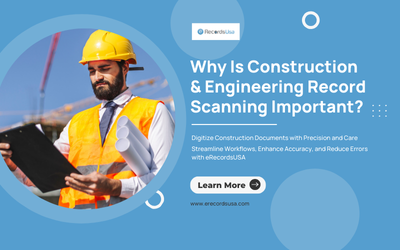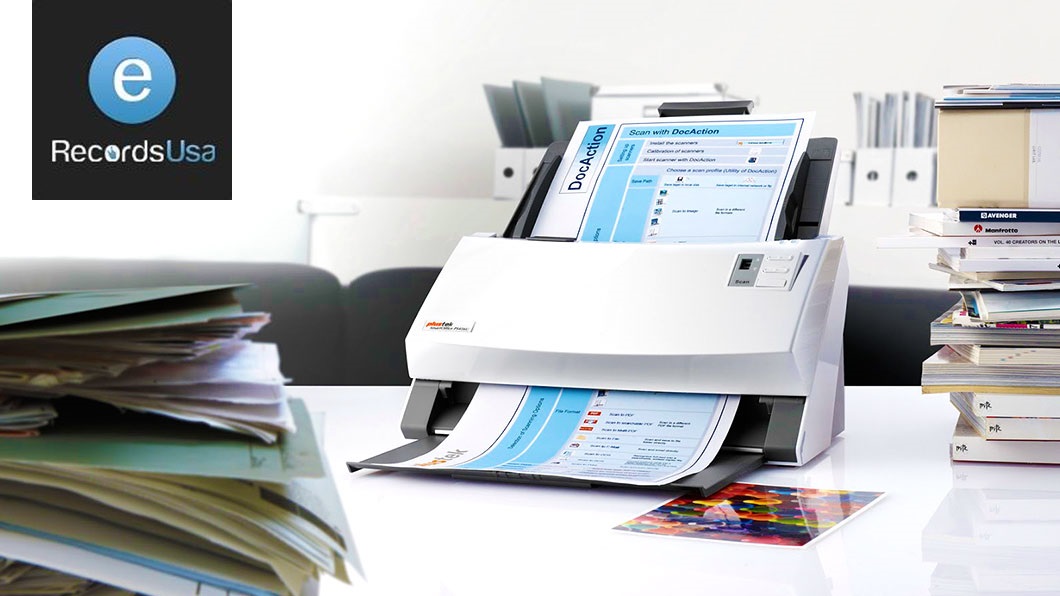Digitizing Construction Documents: Saving Time and Reducing Errors
Are you overwhelmed by the chaos of managing construction documents? Searching for ways to streamline your workflows and minimize costly mistakes?
Being part of the construction industry requires a strong focus on efficiency and productivity. Managing documents can quickly become a challenge, with the risk of them getting lost or containing errors. As a construction project manager, you’re likely all too familiar with this issue. Implementing an organized document management system can protect you from mistakes and misplacements.
Fortunately, document digitization services are available for handling construction documents that simplify document management. Let’s explore how it helps in saving time and reduce errors!
The Current State of Documents Digitization in the Construction Industry
A recent study reveals that only 40% of architecture, engineering, and construction businesses utilize automated workflows to manage their complex projects. This limited adoption results in poor visibility, unpredictable costs, and extended project timelines.
Furthermore, 61% of the companies surveyed rely on multiple software platforms to handle their daily operations. While leveraging software to manage projects is smart, using disparate systems can create inefficiencies. A unified solution, such as connected worker software, could simplify operations by consolidating various functions into a single platform.
Below are some of the key challenges hindering the digitization of the documents in the construction industry.
-
Adoption Challenges
Generational and cultural resistance are significant barriers to the construction industry’s digital transformation. Many stakeholders prefer the status quo and are hesitant to adopt new technologies. Although cost is a factor, the reluctance of the workforce to embrace change presents an even greater obstacle to digital adoption.
This resistance contributes to the construction industry being one of the least digitized sectors. For instance, approximately 29% of small and medium-sized businesses (SMBs) need to adopt new technologies due to resistance to change.
-
Lack of Visibility and Reporting
Construction projects are inherently complex, involving numerous stakeholders and contractors at various levels. For supervisors, tracking the progress of each participant can be daunting, especially when tasks such as data sharing, delegation, risk management, and real-time reporting need to be managed simultaneously. In this context, real-time, comprehensive visibility is crucial.
Poor visibility and reporting can hinder the ability to monitor progress, identify bottlenecks, and make informed decisions, thereby creating significant challenges.
-
Workforce Training
The specialized nature of construction tasks demands highly skilled professionals. Statistics indicate that construction and trades industry will require over 900,000 new recruits over the next decade due to a looming labor shortage, exacerbated by an aging workforce.
Training an aging and change-resistant workforce on advanced software, such as Building Information Modeling (BIM), can be a daunting and costly endeavor.
-
Regulatory and Legal Challenges
The integration of advanced software and digital tools brings with it the need for data storage and sharing. The security of this digital data is paramount, necessitating adherence to regulatory and legal compliance standards.
Navigating the complexities of data privacy regulations, intellectual property rights, cybersecurity standards, and industry-specific regulations presents a significant challenge for the construction industry. Compliance with these standards is essential to safeguard data and maintain legal integrity.
What Types of Construction Documents is Digitized?
A construction site requires a variety of documents to ensure smooth operations and compliance.
Below are some of the most common types of documents used in construction:
- Daily Progress Reports
- Permits
- Maps
- Licenses
- Contracts
- Material Bills
- Pay Slips
- Blueprints
- Engineering or Architectural Drawings
- Safety Protocols
- Quality Checklists
How Digitization of Construction Documents Save Time & Reduce Errors
The digitization of construction documents represents a significant leap forward for the construction industry, offering numerous advantages that streamline workflows, enhance accuracy, and ultimately lead to more efficient project completion.
Below are key ways in which digitizing construction documents saves time and reduces errors.
-
Streamline Document Management
Digitization simplifies this process by allowing easy storage, document retrieval, and sharing of documents.
With all files centralized in a digital format, project teams can quickly access the information they need, reducing the time spent searching for and organizing physical documents.
-
Enhance Collaboration
Digital documentation enables real-time collaboration across teams, regardless of their location. Project stakeholders can simultaneously access, review, and edit documents, ensuring that everyone is on the same page.
This level of collaboration minimizes the risk of miscommunication and reduces the likelihood of errors that could arise from working with outdated or conflicting information.
-
Improve Accuracy and Consistency
Manual data entry and the use of paper documents often lead to errors, such as misinterpretations, omissions, or duplications.
Digital documents, particularly those integrated with software systems like Building Information Modeling (BIM) or Document Management Systems (DMS), ensure that information is accurate, consistent, and up-to-date.
Automation features in these systems can further reduce human error by standardizing document formats and automating routine tasks.
-
Faster Decision-Making
Access to real-time data is crucial in the fast-paced construction industry. Digital documents provide immediate access to critical information, enabling project managers and stakeholders to make informed decisions quickly.
This agility helps to keep projects on track, avoid costly delays, and ensure that any issues are addressed promptly before they escalate.
-
Reduce Rework and Cost Overruns
Errors in construction documents often lead to rework, which can be costly and time-consuming.
By digitizing documents and utilizing advanced tools like version control and change tracking, the likelihood of errors is significantly reduced. This, in turn, minimizes the need for rework, helping to keep projects within budget and on schedule.
-
Enhance Compliance and Risk Management
Construction projects must adhere to various regulatory requirements and industry standards. Digital documentation helps ensure compliance by providing a clear audit trail of all documents and changes. This transparency not only reduces the risk of non-compliance but also makes it easier to manage risks associated with documentation errors, such as legal disputes or project delays.
-
Environmental and Space Savings
Digitizing construction documents also brings environmental benefits by reducing the need for paper. Additionally, it frees up physical storage space that would otherwise be occupied by filing cabinets and paper archives.
This not only contributes to a more sustainable business practice but also reduces overhead costs associated with physical storage and document management.
Digitize Your Construction Documents With eRecordsUSA Today!
In today’s fast-paced construction industry, the ability to access accurate and up-to-date information at the click of a button is not just a luxury—it’s a necessity.
Digital solutions enable your team to collaborate more effectively, make informed decisions more quickly, and ensure that every aspect of your project runs smoothly. At eRecordsUSA, we understand the unique challenges faced by construction professionals and are committed to providing top-notch document scanning services tailored to meet the specific needs of your projects.
Located in the San Francisco Bay Area, our experienced team uses state-of-the-art technology to convert your paper documents into easily accessible, secure digital files. Whether you need to scan engineering drawings, blueprints, or maps, or require comprehensive blueprint archival services, we are your trusted partner in driving efficiency and accuracy in your operations.
Don’t let outdated documentation methods hold your projects back. Contact us today to learn more about our comprehensive document scanning services and start your journey towards a more efficient, error-free construction process. Digitize your construction documents with us and experience the transformative difference that cutting-edge digital solutions can make for your business.
















